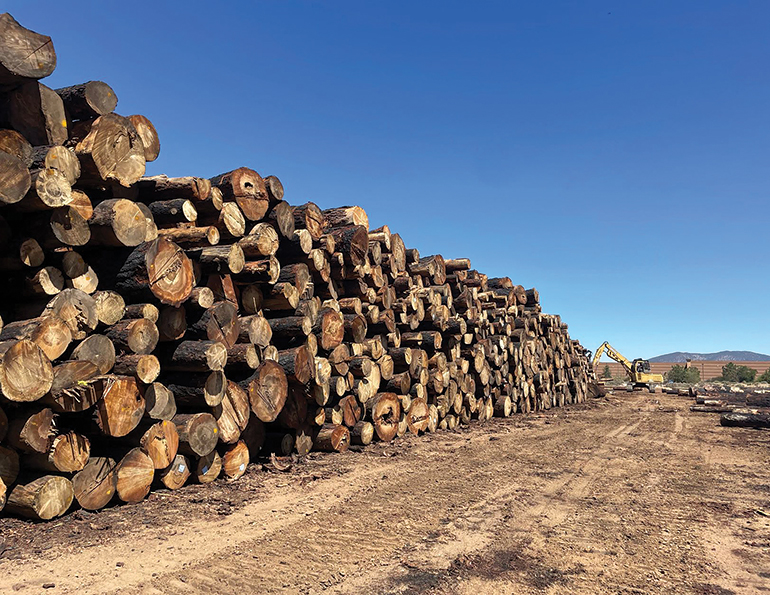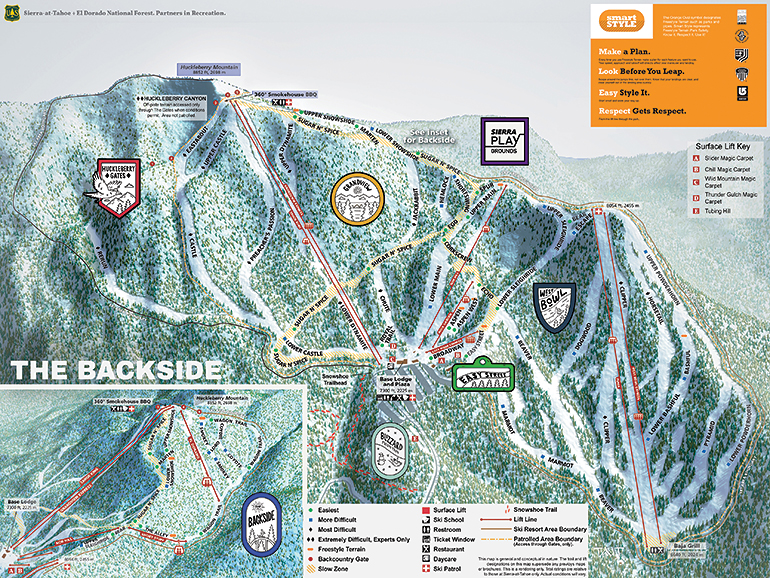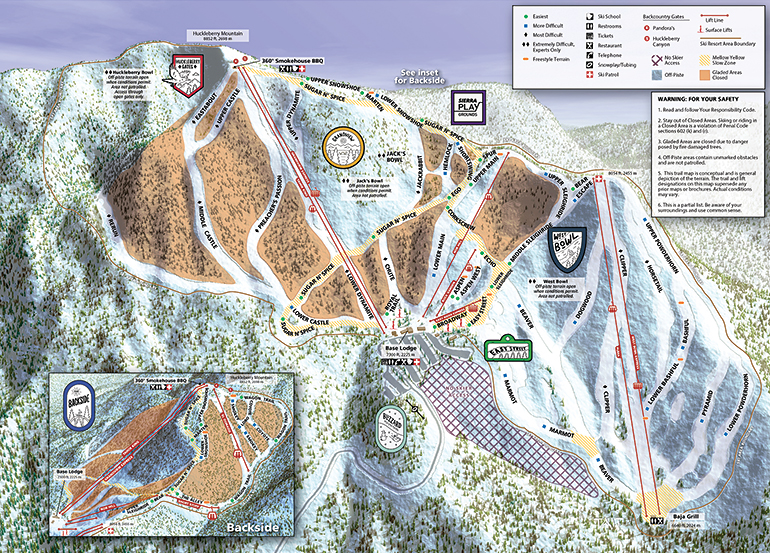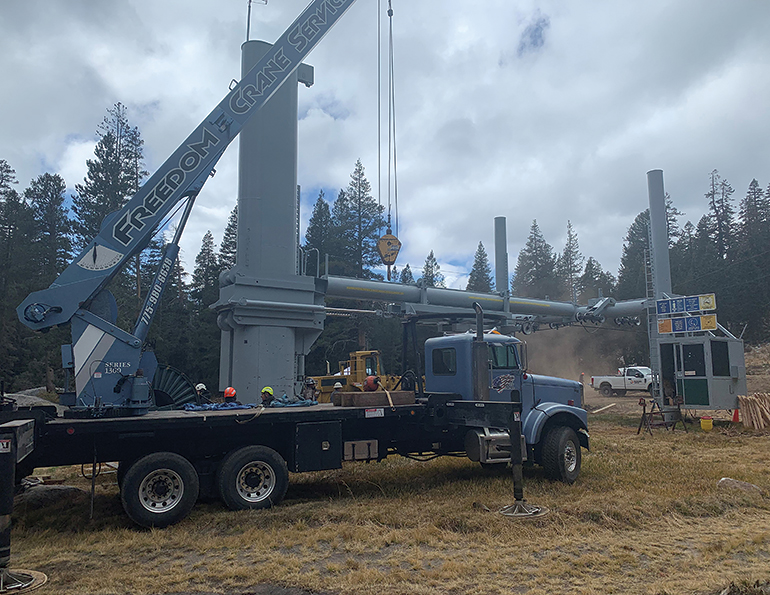Climate change is altering the land on which we operate. An increasingly extreme heat–drought–fire cycle is ravaging the American West (and the globe), and no ski area is more attuned to the impacts of this cycle than Sierra-at-Tahoe. In August 2021, the Caldor Fire continually outmaneuvered thousands of firefighters on its way to charring more than 80 percent of Sierra-at-Tahoe’s footprint, leaving melted infrastructure, thousands of damaged trees, and an inoperable resort littered with new hazards—and, in many ways, new opportunities.
Daunted but unbowed, the Sierra team rolled up their sleeves and, with the help of countless friends and partners, got to work remediating the damage and evaluating the new landscape. Now, just 16 months after the devastating blaze, the resort’s chairlifts are spinning again. This season, visitors will be able to slide on every one of Sierra-at-Tahoe’s cut trails, many of which look very different now.
SAM sat down with the resort’s general manager, John Rice, to reflect on the rebuilding and reopening process.
While the work is far from done, Sierra-at-Tahoe’s recovery is a lesson in resilience: of the land, of the personnel dedicated to reopening and reimagining the resort, and of a community that has come together at every opportunity to support the process.
(Listen to our conversation with John Rice on PodSAM's "Fire on the Mountain, Part 3: A Learning Season")
FOREST FOR THE TREES
“When we first did a post-fire survey of the landscape and looked at what was affected, we realized that we had a big project ahead of us,” says Rice. With so many hazard trees to assess and remove, “the question was whether it was even doable.”
While Sierra-at-Tahoe operates on U.S. Forest Service land and USFS has been a partner in the forest remediation work at the ski area, the responsibility for hazard tree removal falls to the resort. So, Sierra partnered with SE Group to develop a NEPA (National Environmental Policy Act)-compliant plan, and turned to a third-party, the non-profit El Dorado Resource Conservation District (RCD), to direct the effort.
Under this structure, RCD was responsible for submitting a plan to the Forest Service, which then directed funds through RCD to hire the crews to do the work, with additional funding coming from groups like the El Dorado Community Foundation, the resort, and private donations.
Phase one. Given the scope of the project, the remediation is being tackled in phases. The first phase was focused on removing fire-weakened trees from areas with infrastructure and high usage. Using a USFS hazard tree removal policy, the resort settled on a 150-foot buffer zone for the lift corridors and ski trails. In areas where those buffers intersected, the trees were essentially clear cut.
“For example, in the West Bowl area, which is about a third of our real estate,” says Rice, “if you go 150 feet off one trail, then 150 feet off the next trail, that’s pretty much a clear cut there.” While the crews left “anything that was green,” the once densely forested West Bowl is now a true open bowl.
In total, roughly 18,000 trees were removed in phase one. “That’s a pretty big undertaking, especially in a mountainous region with chairlifts and buildings at risk,” says Rice.
 Crews remove fire-damaged trees as part of phase one of remediation.
Crews remove fire-damaged trees as part of phase one of remediation.
“When a forestry group goes in and does this kind of work post-fire, they’re typically not worrying about building roads that could cause problems with ski trails or about trees that could hit chairlifts,” he explains. “So, they had some real challenges, not to mention the fact that there’s a lot of rock here. There are places where they couldn’t build roads. There’s also a lot of steep terrain.”
To accommodate, Atlas Tree Surgery, which performed the work, brought in a variety of specialized equipment: three Albach machines for felling trees and chipping slash, as well as helicopters for removing trees on anything more than a 50-degree slope. Sawyers came in from Idaho, Utah, and Wyoming to drop and cut timber, and by Rice’s estimation, “There were about 50 logging trucks a day heading down to a mill that was put up in Carson City.”
 A stack of trees from Sierra-at-Tahoe awaits processing at a new mill in Nevada.
A stack of trees from Sierra-at-Tahoe awaits processing at a new mill in Nevada.
SUCCESS STORIES
The sawmill, located on Washoe Tribe land near Douglas County, Nev., did not exist before the Caldor Fire. Built by Tahoe Forest Products LLC (TFP) in partnership with the Washoe Development Corporation (WDC), an affiliate of the Washoe Tribe of Nevada & California, the mill came about because there was no market for salvage logs and thinnings from the Tahoe Basin. The mills in California did not need or want more timber because of the last few years of fires, says Rice.
The new mill filled that gap, with its first log purchases coming from the post-fire cleanup efforts at Sierra-at-Tahoe. Going forward, it will be able to process small logs and thinnings from forest health projects aimed at removing excess fuels in the surrounding area.
For Rice, the mill is one of many success stories to emerge from the ashes of the Caldor Fire. “There are cool stories throughout this whole process, and one is that this land the mill is on was just sitting there. For the Washoe Tribe to be able to put 30 or 40 people to work and find a new revenue source, that was awesome for them,” he says. “And I think the Forest Service [which worked with the Washoe Tribe to support development of the mill] is very proud of how they were able to repurpose the timber.”
Repurposing the wood. In total, the cleanup produced an estimated 15- to 20-million board feet of merchantable timber, some of which the resort kept. “We’re trying to repurpose as much of the wood as we can to tell the story,” says Rice. “We’re making some tables, and we’re making name tags for our employees.”
Even the damaged wood is being repurposed to an extent, albeit unconventionally. “There’s a brewery in town that’s making a beer with some of the burnt wood in it,” says Rice. “The brewer, who loves this mountain, wanted a piece of the fire to go into one of his beers.”
A WHOLE NEW WORLD
Like the salvaged trees, the resort itself is also taking on new life. In many ways, the Sierra-at-Tahoe opening this season is a brand-new mountain. “We’re working on our new trail map,” says Rice, as clear a testament as anything to how very different the ski area looks post-fire.
 Sierra-at-Tahoe’s pre-fire trail map shows narrower trails and a densely forested West Bowl area.
Sierra-at-Tahoe’s pre-fire trail map shows narrower trails and a densely forested West Bowl area.
 The new 2022-23 trail map illustrates how the landscape has changed post-fire, with wide open terrain in the West Bowl and previously skiable gladed areas now closed while awaiting remediation.
The new 2022-23 trail map illustrates how the landscape has changed post-fire, with wide open terrain in the West Bowl and previously skiable gladed areas now closed while awaiting remediation.
Sierra has historically been beloved for its tree skiing, but with more remediation work still to come, only Jack’s Bowl and the Huckleberry side-country will open for gladed skiing and riding this year. Other gladed areas that used to be skiable will be closed for the entire winter—and with the potential hazard of falling trees, guests will want to heed the warnings to stay out.
“We’re going to put signs up and hope people are good about understanding the risks,” says Rice, acknowledging that this is all new territory. “We want to make sure that we warn people to not put themselves at risk, or our patrollers at risk having to go find them.”
Ops impacts. With fewer trees comes new challenges, like less protection from wind and other elements.
“Our storms typically come out of the southwest,” says Rice, as did the first storm of Sierra’s season. But, without the buffer of the West Bowl trees, “the winds that came scoured a lot of that snow and pushed it all to the east side. A couple weeks later we got an east wind that pushed it all back.”
“It’s going to be a learning season,” he adds. “We’ve got to get open, get some momentum, and start to learn what kind of snow deposition we’re going get and how the wind’s going to affect that.”
To prepare, he’s taking tips from resorts that are above tree line. “We’ve already been to Mammoth a couple times, looking at what kind of snow fences they use to catch snow. And we’re going to be doing a lot of snow farming and grooming,” Rice says.
On a side note, Mammoth, Calif., is one of countless resorts, industry personnel, and local businesses that have aided Sierra’s recovery. In one act, a former employee with a tree service company brought in his crew and cut more than 100 dead trees from around Sierra’s tubing hill. Snow Valley, Calif., gave Sierra some double lift chairs, and Dopplemayr helped the resort rush a delayed order. Ed’s Electronic provided splice boxes for comm line, and snowmobiles were donated by June Mountain and Palisades Tahoe, Calif.
As far as changes to resort operations go, the reduction in wind protection may impact lifts as well as grooming. “We’ve been known for wind protection forever, and now that’s a new thing we have to deal with,” Rice says. “There’s still a lot of trees on the east side, but on the west side, it’s going to be a different ballgame.”
The changes aren’t all bad, he notes. “Our terrain park crews are drooling over the new landscape opportunities.”
Other benefits of the newly wider trails include more places to put race lanes and fewer compression areas and pinch points for ski and ride lessons. The new skiable terrain between trails on West Bowl will provide fun new experiences, too, once it’s filled in with snow.
“We’ll continue to get creative and just have fun with the new landscape and listen to our guests,” says Rice. “They’re going to tell us what works and what doesn’t.”
 A crew from neighboring Palisades Tahoe helps rebuild Sierra’s Short Stuff chair.
A crew from neighboring Palisades Tahoe helps rebuild Sierra’s Short Stuff chair.
STUMBLING BLOCKS AND STEPS FORWARD
While opportunities abound, the season is beginning with its fair share of stumbling blocks. To start, the majority of Sierra’s staff were encouraged to take jobs elsewhere after the fire shuttered the ski area for the 2021-22 season. Some have come back, but many have found success at other resorts and businesses. In early December, Sierra was only staffed at about 60 percent.
Still, Rice is optimistic: “A lot of the other resorts aren’t hiring anymore, and we still are.” It helps that housing capacity is increasing in South Lake Tahoe, with short-term rentals like VRBO and Airbnb reentering the more seasonal market. Sierra is also bringing in J-1 visa holders to round out the staff. Some new staff members have already defected from neighboring resorts, too.
Rice habitually asks new hires why they have come to Sierra-at-Tahoe. “Almost across the board they say, ‘I want to be part of the rebirth of this resort.’” Which is good, he adds, since “essentially, everyone’s been told, including me, ‘forget about your job title because it’s going to be all hands serving.’”
Learning opportunities. While Sierra has, perhaps, a larger rehiring hurdle than its other seasonal competitors, Rice and a core group of 40 employees have remained on site since the fire to see Sierra through recovery to opening day.
In an unexpected blow, when director of mountain operations Paul Beran died this summer, Rice and his team lost a dear friend and the man Rice was training as his successor. “Paul Beran—we’ve dedicated the season to him,” says Rice.
Despite the loss, Rice is hopeful about the staff that will lead the resort going forward. “We’ve got some really solid people that want to grow,” he says, noting that there were nearly a dozen internal applicants for Beran’s role.
Almost by default, growth opportunities have been abundant during the past year. “They’re getting to learn about the insurance side of it. They’re getting to learn about working with public agencies. They’re getting a lot of growth in a short period of time,” says Rice.
“Our lift maintenance team got 10 years of experience in one summer” performing five haul-rope splices, he adds. “I’m just really stoked when I look in the eyes of the people that are going to help us carry this place into the future and the growth they’ve had.”
LOOKING AHEAD
After the season, it will be back to land remediation. Revegetation work—key to promoting soil and water conservation, fire resilience, and biodiversity in the forest—is scheduled to begin next year.
RCD prioritized erosion control work this year, as well as focusing on its vegetation management program, per the forest service agreement, says Rice. The erosion control involved distributing wood chips from the tree slough on disturbed dirt, water bar work, and maintaining the temporary logging roads.
Next spring, RCD will be back on site to begin the next phase of erosion control and revegetation. “There’s 8,000 seedlings that are already put aside—red firs and sugar pines and others—that we will then plant,” says Rice.
Community. As with so many things at Sierra-at-Tahoe, this next phase of recovery will depend on community support. “We’re looking at adopt-a-tree initiatives, at having days where our pass holders can plant a tree—all kinds of different programs,” says Rice.
“We’ve been heavily invested in our community for 30 years, helping to support the arts, youth recreation, education,” he adds. “So, when we were down, a lot of people were cheering for us, and still are.”
Indeed, the community has come together at various points throughout the last 16 months to raise money for the resort. One fundraiser, focused on supporting Sierra employees, was held at the Hangar Taproom in South Lake Tahoe. McPs Irish Pub hosted an event for employees who suffered personal equipment losses. Another local pub, MacDuff’s, donated all sales one day toward the resort.
 Strong turnout at a local community fundraiser for resort employees held at the Hangar Taproom.
Strong turnout at a local community fundraiser for resort employees held at the Hangar Taproom.
Sierra, through RCD, is also looking to leverage corporate donors going forward. Though RCD’s efforts to involve big companies like Facebook and Intel ahead of the clean-up efforts didn’t pan out, RCD feels that they’re going to be able to get a lot of donors to help with reforestation. “That’s something people would feel good about,” Rice says.
Rice feels good, too, about the ability of the mountain, the community, and the staff to continue to bounce back better. “Our team is determined to get the door open and bring people back into the resort, bring our loyal folks back, our employees back, recreate recreational opportunities, and start to work with new opportunities as we plan capital projects down the road,” he says.
“There is going to be a lot of learning this year, but the resiliency of this group is incredible.”






